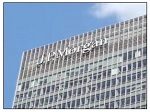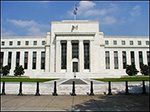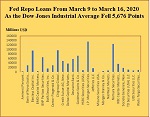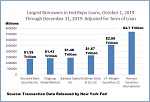-
Recent Posts
- Wall Street’s Megabanks Have Trillions of Dollars Off-Balance Sheet, in a Replay of Accounting Hubris that Led to the 2008 Wall Street Collapse
- JPMorgan Remains the Second Largest Money Market Fund Manager, Despite Needing Billions in Money Market Bailouts from the Fed in 2020
- The First Bank Failure of 2024 Leaves a 1-Cent Stock for Investors and $667 Million in Losses for the FDIC
- Catch and Kill Protection Rackets: Trump, Weinstein, Epstein and Wall Street
- Wall Street’s Judge Shopping Continues: It’s Trying to Stop the FTC’s Ban on Worker Handcuffs Known as Non-Compete Agreements
- The Fed Tallies Up a Big Threat to Financial Stability in the U.S.: “Runnables” at $21.3 Trillion
- Billionaire-Owned Media Has Gone Full Throttle to Save Fellow Billionaire, Jamie Dimon
- The Professor Who Wrote the Seminal Book on Wall Street Megabanks Calls Today’s Financial System “Dangerously Unstable”
- Gold Has Set Historic Highs this Year as the Federal Reserve Has Reported Historic Losses
- Stanford Finance Professor Anat Admati Is Making Jamie Dimon Very Nervous – Again Calling His Bank “Dangerous”
- Jamie Dimon Dumped $150 Million of His JPMorgan Stock in February; Now He Says His Regulators Want 25 Percent More Capital at his Bank
- The Black Swan Rears Its Head: The Fed Has Negative Capital Using GAAP Accounting
- New York Fed Will Not Confirm or Deny that 5-Count Felon JPMorgan Chase Is Custodian of $2.4 Trillion of Its Securities
- For the First Time in History, the Fed Is Reporting Billions in Losses Weekly; It’s Still Paying High Interest Income to the Mega Banks on Wall Street
- There’s a Revival of the Dotcom-esque Froth in Today’s Markets; Cathie Wood Is Standing in for Henry Blodget and Jack Grubman; Nasdaq Is Playing Nasdaq
- Study Finds Wall Street Mega Banks Have Overstated Income for Years on Commercial Real Estate Loans They Sell to Investors
- Jamie Dimon Huddles in Private with Biden Bigwigs as His Bank Faces More Crime Charges
- Report: Five Banks Have a Combined Half Trillion Dollars in Commercial Real Estate Loans; Number 1 is JPMorgan Chase
- Billionaire Larry Fink of BlackRock, Which Grabbed Fed Bailouts in 2020-2021, Lectures Struggling Seniors on Making More Sacrifices
- Almost 10,000 U.S. Banks Have Disappeared Since 1985, Leaving 4 Mega Banks Controlling 39 Percent of Bank Assets
- Wall Street’s Go-To Law Firm, Sullivan & Cromwell, Got in Bed with Crypto; Now Its Reputation Is Being Hammered
- More Failed Banks and Office Building Demolitions Likely Before Real Estate Problems End, Warn Two Federal Agencies
- During Spring Bank Panic of 2023, Liquidity Advances from FHLBs Topped Those of Q4 2008, when Wall Street Was in Collapse
- JPMorgan’s Federally-Insured Bank Is Fined $348 Million for Losing Track of “Billions” of Trades
- Hedge Fund Titan John Paulson Made $1 Billion in an Illegal Goldman Sachs Deal; Trump Is Now Floating Him for Treasury Secretary
- Wall Street Mega Banks Have Drawn a Law-Free Zone Around Themselves – The Media Is Complicit
- A Financial Writer at New York Times Admits He’s Been Misrepresenting Bank Capital for 14 Years
- FDIC Data Contradicts Fed Chair Powell: Shows Real Estate Problems Have Skyrocketed at Largest U.S. Banks, Not the Smaller Regionals
- Senator Elizabeth Warren Calls Fed Chair Powell “Weak-Kneed”; Says He Is “Driving Efforts Inside the Fed” to Gut Higher Capital Requirements
- Steve Mnuchin, Trump’s Treasury Secretary/Foreclosure Kingpin, Joins with Hedge Fund Guys to Grab a Teetering, Federally-Insured Bank for $2 a Share
- Wall Street Mega Banks Have Created a Circular Firing Squad with Credit Derivatives and Capital Relief Trades – with the Fed’s Blessing
- New York Community Bancorp Was JPMorgan’s Top Regional Bank Pick for 2024; It’s Lost 73 Percent Y-T-D and Had Its Deposit Rating Downgraded to Junk
- Watchdog, Better Markets, Investigates the Bank that Has Lost 65 Percent of Its Market Value in Two Months and Was Downgraded to Junk by Moody’s
- The Fed Pretends to Send a Warning to Wall Street’s Mega Banks on Derivatives and Counterparty Risk
- $87 Million Buys This for Jamie Dimon: David Boies Can’t Utter the Words “JPMorgan Chase” in a Jeffrey Epstein Sex Trafficking Case
- Jamie Dimon and Nine of His Top Executives at JPMorgan Chase Have Dumped Over $150 Million of their JPMorgan Stock in Last Two Months
- These Charts Reveal Why the Fed Is Frightened about Capital Levels at the Wall Street Mega Banks
- Wall Street Law Firm Sullivan & Cromwell Gets Sued Over Allegations It Aided and Abetted the FTX Crypto Fraud
- JPMorgan Says Its “Trading Venues” Are Under Investigation While It’s Still on Probation for Prior Trading Crimes
- Jamie Dimon Is Desperate to Pin the Jeffrey Epstein Scandal on Jes Staley; Bloomberg News Is Carrying His Water — Again
- Citigroup Is Having a Very Bad Week; Regulators Are Breathing Down Its Neck
- Five Wall Street Banks Hold $223 Trillion in Derivatives — 83 Percent of All Derivatives at 4,600 Banks
- Jamie Dimon’s Statement Last Month that Trump “Was Kind of Right About NATO,” Sounds Even More Unhinged Today
- S&P 500 Sets a Record on Wednesday as Banks Continue Tanking
- NYCB Downgraded to Junk; Shocking Charts for Citigroup, Barclays and Deutsche Bank
- Reporters Who Ask Tough Questions at Fed Press Conferences Have a Habit of Being Disappeared from the Room
- Jamie Dimon Has Spent $117 Billion Propping Up JPMorgan’s Share Price with Buybacks in 10 Years; He’s Counting on Trump’s MAGA Crowd to Rescue Him
- Bank Fraud Enters a New Era: Bank-to-Bank Wire Transfers Loot Customers
- Senator Sherrod Brown Takes on the Fed’s Support of Wealth Stripping the Middle Class
- JPMorgan Chase Has Used the Same Auditor for 58 Years, Despite Giant Frauds at the Bank in the Last Nine Years
Search Results for: trillion
At Year End, JPMorgan Chase Held Over $1 Trillion in Uninsured Deposits Versus $119 Billion at First Republic

By Pam Martens and Russ Martens: March 21, 2023 ~ Jamie Dimon is the Chairman and CEO of JPMorgan Chase, the largest bank in the U.S., which is also ranked the riskiest global bank by its regulators. But instead of getting his own house in order in the midst of a banking crisis, Dimon has been peculiarly focused elsewhere. Over the past five days, Jamie Dimon’s legions of publicists have been burning up the phone lines with reporters, pushing the narrative that Jamie Dimon is some kind of financial wizard who needs to have a seat at the table to save the regional bank, First Republic Bank. (Scroll down here to see the exhaustive public relations effort that has gone into this narrative.) Last Thursday, news hit the wire services that Dimon had lined up 11 banks willing to place $30 billion in uninsured deposits into First Republic Bank. JPMorgan Chase, … Continue reading
After Funneling Trillions of Dollars in Repo Loans to Serial Bank Offenders, Lorie Logan Gets a $440,000 Job Running the Dallas Fed

By Pam Martens and Russ Martens: September 8, 2022 ~ Bailing out the Wall Street megabanks that are serially fined and hit with felony counts appears to be catching on as a major career advancement strategy at the New York Fed. On August 22, Lorie Logan began her big promotion as President of the Dallas Fed, a position that paid $440,700 at the end of 2020. That’s $40,700 more than the salary of the President of the United States. Prior to joining the Dallas Fed, Logan was the Manager of the System Open Market Account (SOMA) at the New York Fed, effectively the Fed’s trading floor. As part of her job, Logan oversaw the trillions of dollars that were electronically created at the New York Fed to bail out Wall Street trading houses in the fall of 2019 and through the middle of 2020. (See our related report The Fed Appears … Continue reading
Internal Charts Show Treasury Agency Assigned to Measure Risk in U.S. Markets Slept through the Repo Crisis of 2019 and the Fed’s $19.87 Trillion Bailout

By Pam Martens and Russ Martens: July 7, 2022 ~ The Office of Financial Research (OFR), a unit of the U.S. Treasury Department, was created under the Dodd-Frank financial reform legislation of 2010. Its job is to prevent, through early warnings, the kind of catastrophic financial crisis that occurred in 2008 when irresponsible and corrupt practices on Wall Street toppled the U.S. economy; brought on the deepest financial crisis since the Great Depression; and left the taxpayer and Fed bailing out the Wall Street megabanks that would have otherwise collapsed from their own hubris. Unfortunately, the OFR was savagely gutted under the Trump administration. Today, OFR is like the cop on the beat that has been stripped of his whistle, his walkie-talkie and is wearing dark sun glasses on a cloudy day. One of the tools that the OFR is supposed to use to warn federal regulators that Wall Street is … Continue reading
JPMorgan Chase’s Derivatives Spike by $14 Trillion in First Quarter to Six-Year High of $60 Trillion

By Pam Martens and Russ Martens: June 24, 2022 ~ Add JPMorgan Chase, the biggest bank in the United States with an unprecedented five criminal felony counts since 2014, to the growing list of debacles of which the Fed has lost control. The Fed has its bank examiners pouring over the books of JPMorgan Chase on an ongoing basis, but somehow the bank’s dangerous book of derivatives has been allowed to spike by $14.42 trillion in the first quarter of this year, soaring from $45.84 trillion on December 31, 2021 to $60.26 trillion on March 31, 2022. That’s an increase of 24 percent in a three-month span. That information comes from page 18 of the newly-released report on derivatives in the banking system from the Office of the Comptroller of the Currency (OCC). The Dodd-Frank Act of 2010 was supposed to stop the insanity of unfathomable amounts of risky derivatives being … Continue reading
Is the Crypto Threat to U.S. Financial Stability $889 Billion or $10 Trillion?

By Pam Martens and Russ Martens: June 23, 2022 ~ Yesterday, Benzinga reported on a curious statement made by Fed Chair Jerome Powell during his appearance before the Senate Banking Committee on Wednesday. Powell was asked by Senator Kyrsten Sinema (D-AZ) if the Fed had been tracking the events in the crypto markets in the past several weeks. Powell responded that the Fed was watching those events “very carefully” but the Fed “did not see significant macro-economic implications.” The article goes on to lend credence to this observation from the Fed by noting the following: “It is important to note the entire cryptocurrency market cap is $889.25 billion versus the American GDP, which is $25.34 trillion, and an equities market that controls more than $49 trillion.” Before we drill down into the weeds of that crypto market cap figure, it’s important to note that former Fed Chair Alan Greenspan told Congress that he saw no major … Continue reading
Fed Chair Powell Telegraphs the Perfect Storm for Wall Street’s Megabanks: Rapid Rate Hikes Hitting $234 Trillion in Derivatives

By Pam Martens and Russ Martens: April 25, 2022 The Federal Reserve (the Fed) is the central bank of the United States. It sets monetary policy, including control of the benchmark short-term interest rate known as the Federal Funds rate, or in Wall Street jargon, the “Fed Funds” rate. This is a key rate because it signals the rate at which overnight loans are made between financial institutions and the direction of interest rates in general. Unfortunately, over time, the Fed has also been granted a supervisory role by Congress over Wall Street’s megabanks alongside its ability to bail them out when its crony brand of supervision fails. There was an epic failure in the Fed’s supervision of the Wall Street megabanks in the leadup to the 2008 financial crash and the September 2019 repo blowup. In both cases, the Fed made trillions of dollars in cumulative loans at below-market interest … Continue reading
While JPMorgan Chase Was Getting Trillions of Dollars in Loans at Almost Zero Percent Interest from the Fed, It Was Charging Americans Hit by the Pandemic 17 Percent on their Credit Cards
By Pam Martens and Russ Martens: April 21, 2022
Under just three of the emergency bailout programs offered by the Fed to Wall Street, units of the megabank JPMorgan Chase tapped over $6 trillion in cumulative (term-adjusted) loans from September 17, 2019 through the first quarter of 2020. That figure will definitely go higher as the Fed is releasing the names of the banks and the amounts they borrowed on a quarterly basis for its repo loan program.
Thus far, the numbers stack up as follows: a trading unit of JPMorgan Chase borrowed $6.19 trillion from the Fed’s repo loan program from September 17, 2019 through March 31, 2020. (Those are cumulative, term-adjusted figures.) A significant chunk of that money was borrowed at interest rates as low as 0.10 percent. The loans were collateralized with mostly treasury securities and agency mortgage-backed securities (MBS).
A trading unit of JPMorgan Chase also borrowed $400 billion in cumulative, term-adjusted loans from the Fed’s Primary Dealer Credit Facility (PDCF) during 2020. All of those loans were made at a fixed rate of 0.25 percent even though the Fed accepted lower-grade collateral, such as asset-backed securities, for some of the loans.
JPMorgan Chase’s money market funds also needed to borrow a cumulative $24.8 billion from the Fed’s Money Market Mutual Fund Liquidity Facility (MMLF) to bail themselves out during March and April of 2020. Some of those loans didn’t mature until 2021. JPMorgan borrowed from the Fed’s MMLF at rates between 0.50 and 1.25 percent.
While JPMorgan Chase, which has admitted to five criminal felony counts since 2014, was getting these sweetheart deals from the Fed, it was charging Americans who were struggling from the impact of the COVID-19 pandemic as much as 17 percent on their credit cards. You can read one of its credit card customer’s complaints about that 17 percent interest at this link at the Consumer Financial Protection Bureau’s (CFPB) complaint database.
Another JPMorgan Chase customer wrote to the CFPB that their employer filed for bankruptcy during the pandemic, leaving them unemployed. The customer said that when they asked JPMorgan for assistance in reducing the monthly amount they had to pay on their credit card, they were offered the following options: convert to a 60-month repayment plan with interest rates starting at 12 percent; no payment for 90 days but interest would continue to accrue at 14.24 percent; negotiate a payoff of the total principal balance of $14,000 with a 10 percent discount. (Where exactly would an unemployed person get $12,600 when they can’t meet their monthly credit card payment.) You can read the text of that complaint here.
We asked the CFPB database to show us just complaints against JPMorgan Chase since it started receiving those cozy low-interest repo loans from the Fed on September 17, 2019 – months before any COVID-19 cases had been reported anywhere in the world. The database turned up 28,974 complaints. You can browse through them here.
If you want to gauge the compassion that JPMorgan Chase has for its own low-wage tellers, you can read our report here. Despite the five felony counts and a rap sheet that would make the Gambino crime family blush under the leadership of Chairman and CEO Jamie Dimon, JPMorgan Chase’s Board has turned Dimon into a billionaire – on the backs of its low-wage tellers and customers paying double-digit interest rates on credit cards during a pandemic and declared national emergency.
In a Six-Day Span in March 2020, the Dow Crashed 5,676 Points; the Fed Responded with Almost $1 Trillion in Repo Loans to 24 Trading Houses

By Pam Martens and Russ Martens: April 4, 2022 ~ The Federal Reserve, the central bank of the United States, has a “dual mandate” to target inflation and to maintain “maximum sustainable employment.” The Fed has zero mandate to target a specified level for the Dow Jones Industrial Average or to prevent stock market crashes by printing money out of thin air and pumping it out to the trading houses on Wall Street. But under Fed Chair Ben Bernanke during the Wall Street crisis in 2008 and Fed Chair Jerome Powell in 2019-2020, that’s exactly what the Fed decided to do. The majority of the stock market is owned by the wealthiest 10 percent of Americans. Thus, when the stock market is bailed out by the Fed, which we can now show overtly occurred from March 9 through March 16 of 2020, the Fed is effectively bailing out the rich. The … Continue reading
Nomura, JPMorgan and Goldman Sachs Received a Cumulative $8 Trillion from the Fed’s Emergency Repo Loans in Fourth Quarter of 2019

By Pam Martens and Russ Martens: January 17, 2022 ~ The Dodd-Frank financial reform legislation of 2010 ordered the Government Accountability Office (GAO), an investigative body for Congress, to audit the Fed’s alphabet soup of emergency lending programs conducted during and after the 2008 financial crisis. The GAO found that a cumulative $16.1 trillion had been pumped out to Wall Street firms by the Fed – at super cheap interest rates. The GAO provided data for the peak amounts outstanding and also a cumulative total. Why is a cumulative total essential and relevant? Because one institution in 2008, Citigroup, was insolvent for much of the time the Fed was flooding it with cheap loans. (Under law, the Fed is not allowed to make loans to an insolvent institution.) And when an insolvent institution is getting loans rolled over and over by the Fed for a span of two and a half … Continue reading
Wall Street Banks Have an Alibi for their $11.23 Trillion in Emergency Repo Loans from the Fed – It’s a Doozy

By Pam Martens and Russ Martens: January 6, 2022 ~ From September 17, 2019 through July 2, 2020, the trading units of the Wall Street megabanks (both domestic and foreign) took a cumulative total of $11.23 trillion in emergency repo loans from the Federal Reserve. The loans were conducted by one of the 12 regional Fed banks, the Federal Reserve Bank of New York – which is literally owned by megabanks, including JPMorgan Chase, Goldman Sachs, Citigroup, Morgan Stanley and others. The New York Fed is also responsible for sending its bank examiners into these same banks to make sure they aren’t plotting some evil scheme that will bring down the U.S. economy, as they did with their derivatives and subprime debt bombs in 2008. Unfortunately, if a New York Fed bank examiner doesn’t listen to the “relationship managers” at the New York Fed, and insists on giving a negative review … Continue reading


